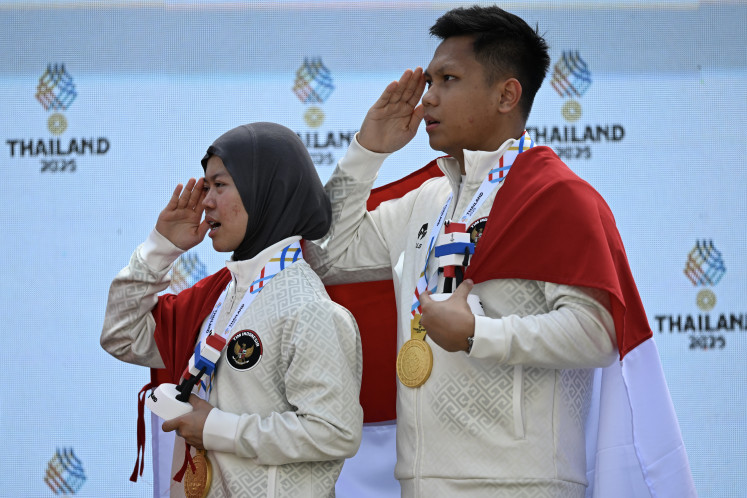Popular Reads
Top Results
Can't find what you're looking for?
View all search resultsPopular Reads
Top Results
Can't find what you're looking for?
View all search resultsA light, layman's look at Indonesia's history
Around 13 years ago, a backpacker from England arrived in Bali
Change text size
Gift Premium Articles
to Anyone
Around 13 years ago, a backpacker from England arrived in Bali.
The backpacker, named Tim Hannigan, wanted to surf the beaches of Bali and with his passion for history, wanted to know more about the island's ' and Indonesia's ' past.
So, he visited a bookshop in Bali.
'I wanted to find something that was easy, something that would introduce me to Indonesian history without putting too much pressure on my brain,' he said.
'[The history books there] were either very focused on one topic or they were very academic. There was really nothing targeted at someone like me at that time.'
For the next couple of years, Hannigan frequently visited Indonesia and at one point, he found work and lived in the country. Still however, he could not find any history books about Indonesia that met his needs.
Finally, Hannigan decided to write such a book himself.
'I write this book to create something for people like me [...] So, the next time a new version of me comes to Bali and looks for what I was looking for back then, they will find it here in this book,' Hannigan said during his latest book launch at Periplus bookstore in Plaza Indonesia in Jakarta on Thursday.
The book is titled 'A Brief History Of Indonesia' ' Sultans, Spices and Tsunamis: The Incredible Story of Southeast Asia's Largest Nation. This is Hannigan's second book about Indonesia. Previously, he has written and published a book titled Raffles and the British Invasion of Java.
In his A Brief History, in less than 300 pages, and 90,000 words, Hannigan chronicles the long history of the Indonesian people from the prehistoric age until the current era of President Joko 'Jokowi' Widodo.
He divides his book into ten chapters, each of them discussing a different important period of Indonesia's history.
The first chapter of Hannigan's book begins with a story of the first encounter between Melanesian homo sapiens and the homo floresiensis, an ancient species of the human race that roamed on Flores and surrounding islands from 38,000 years ago, up until roughly 13,000 years ago.
In the following chapters, Hannigan transports his readers through time as he introduces the history of the Hindu-Buddhist kingdoms, the arrival of Islam, the colonization by European countries, the nationalist revolution movement, the years of Sukarno, Soeharto's New Order and the era known as Reformation.
The topics that Hannigan discusses in the book are heavy and he includes a look at the varying contexts, particularly geo-political factors, behind them.
However, Hannigan, a feature writer who hones his writing skills by reading a lot of fiction, manages to capture this heavy and rich history in a very easy to understand and entertaining narrative.
JP/Hans David
In some parts of the new book, Hannigan uses satire to correct some common misperceptions about Indonesia's history.
For example, most Indonesians, until now, still think that when the Dutch visited Indonesia, they were very attractive and civilized and highly intellectual. In Hannigan's book, however, he gives proof, based on old written documents, of how in reality, the Dutch and the Europeans in general were actually not like this at all.
To achieve what Hannigan has with his book is definitely not an easy task and it's no surprise that he needed a long time to get it finished and published.
'From the project being approved to its publication took two years. So, it was really one year of writing the first proper draft and then another year of making it shorter. Behind that, however, was 10 years of reading about Indonesian history. So, even if I did not realize it, I have been preparing for 10 years,' Hannigan said.
'The single biggest challenge was to make it short. From the beginning, the contract stipulated that it had to be no more than 90,000 words. When I started it, I thought that would be easy. Most people when they are writing a novel, struggle to write enough ' for me, it's the complete opposite. I fairly quickly made it to 150,000 words and then I had to cut back.'
A complete history of Indonesia could not be condensed into a tiny 300-page book with less than 90,000 words and Hannigan realizes this. However, this fact should not undermine the success of Hannigan's book or other popular history works.
For Hannigan, he believes books like his will make history more interesting and will eventually encourage more people to learn about it.
'I didn't like history when I was at school because I think, as happens more or less in every country in the world, you aren't introduced to history in an interesting way,' Hannigan said.
'Books like these are not academic books and maybe that's why there is this traditional idea that you don't give them to kids to read at schools. If the kids somehow manage to survive through school and all of that and still be somehow interested in history then they can read this kind of book. I think we should [change this situation],' he said.
'So I think it would be great if there were books like mine everywhere for everyone. It would start [students off] with a broader context and then, if they were still interested, they could go on to look into more formal details.'











